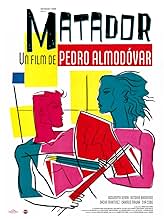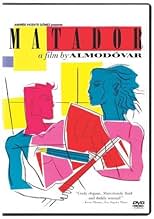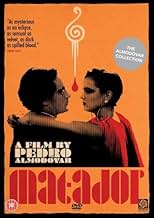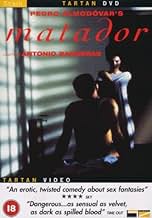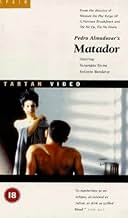IMDb रेटिंग
6.9/10
13 हज़ार
आपकी रेटिंग
अपनी भाषा में प्लॉट जोड़ेंA matador is wounded by a bull and can no longer kill in the arena. It is just one of the problems of one of the characters that unexpectedly collide in this film.A matador is wounded by a bull and can no longer kill in the arena. It is just one of the problems of one of the characters that unexpectedly collide in this film.A matador is wounded by a bull and can no longer kill in the arena. It is just one of the problems of one of the characters that unexpectedly collide in this film.
- पुरस्कार
- 6 जीत और कुल 6 नामांकन
Nacho Martínez
- Diego
- (as Nacho Martinez)
Bibiana Fernández
- Vendedora Flores
- (as Bibi Andersen)
Verónica Forqué
- Periodista
- (as Veronica Forque)
Mercedes Jiménez
- Alumna 3ª
- (as Mercedes Jimenez)
Francesca Prandi
- Alumna 4ª
- (as Francesca Romana)
फ़ीचर्ड समीक्षाएं
If you're a fan of Pedro Almodovar, you'll love this one from 1986.. filmed in Madrid, it has all the usual elements: offbeat characters who meet up and get even crazier, like atoms smashing together. when a young matador Angel (Antonio Banderas at 26) thinks his heroes have committed crimes, he confesses to them to take the fall. watch that opening scene.. .pretty rough stuff: (simulated) sex, nudity, and murder, all in one. his lawyer has her own kinky issues, and wants to defend Angel. Look for the usual Almodovar cast, with Carmen Maura and Chus Lampreave. Assumpta Serna is the sexy, flirty, over-sexed Maria. and the gory bullfights, which play a big part in the story. Secrets. everyone has their secret. which ones will come out? Liaisons... more secrets. will the police find the real killer(s)? it's very good. intrigue.
The connection between sex and death is not a novel one. Elizabethan poetry would occasionally use the latter as a metaphor for the former. Pedro Almodóvar's sixth feature is about three people who have erased the line between the two: Nacho Martinez, a matador gored in the ring, who now teaches students on the art; Antonio Banderas, one of his pupils; and Assumpta Serna, a lawyer defending Banderas who is charged with raping and killing two girls.
In other words, it's one of Almodóvar's movies about the weird kinks of the world. This time, however, he is not concerned with the people at the edge of Spanish society, but at the center of the normal world... assuming there is such a thing. We are all weird, we all act outside the norms, and the people we respect can be the most bizarre.
It's rather slow-moving for one of his movies, probably because this is not one of his shock comedies - although there are comic elements. Visually, it is sumptuous, with a focus on colors, particularly bright reds that draw one's eyes. Miss Serna is a sharp dresser, and she wears a cape in several scenes, which she whirls like a bullfighter going in for the kill.
Is Almodóvar decrying bullfighting? Or in favor of consensual activity of whatever sort? Has he simply presented his bizarre story, and left his audience to draw the moral conclusions it chooses? Or is this simply the sort of story he likes to tell? I think the last is true, but there's nothing simple about it.
In other words, it's one of Almodóvar's movies about the weird kinks of the world. This time, however, he is not concerned with the people at the edge of Spanish society, but at the center of the normal world... assuming there is such a thing. We are all weird, we all act outside the norms, and the people we respect can be the most bizarre.
It's rather slow-moving for one of his movies, probably because this is not one of his shock comedies - although there are comic elements. Visually, it is sumptuous, with a focus on colors, particularly bright reds that draw one's eyes. Miss Serna is a sharp dresser, and she wears a cape in several scenes, which she whirls like a bullfighter going in for the kill.
Is Almodóvar decrying bullfighting? Or in favor of consensual activity of whatever sort? Has he simply presented his bizarre story, and left his audience to draw the moral conclusions it chooses? Or is this simply the sort of story he likes to tell? I think the last is true, but there's nothing simple about it.
I am not sure what to expect when the opening scene is a man masturbating to torture porn, a term that was probably not even invented in 1988.
From there we go to alternating clips of Antonio Banderas asking the ex-bullfighter Nacho Martínez about women and he compares getting a woman to bullfighting, while we watch someone do exactly that. We are no, of course, prepared for the necrophilia twist in that encounter.
We find our boy, Antonio, and he is a boy in this film, in a strict Catholic household. I would have to guess that his mother was Opus Dei. He attempts to rape his neighbor and confesses to four murders which we know he did not do. This is just Almodóvar's take on religion and repression. He revisits that subjects again in the film, so it must me a theme for him.
But, then the story shifts to Nacho and Assumpta Serna, with Eva Cobo in a minor role. This is where the story gets interesting with the police trying to solve the four murders and the real murderers trying to lay it on Antonio.
It gets bizarre at the end with Antonio seeing the killers in his mind and leading the police to them. But, they arrive too late as the climax of sex and death occurs simultaneous with an eclipse. How weird is that?
From there we go to alternating clips of Antonio Banderas asking the ex-bullfighter Nacho Martínez about women and he compares getting a woman to bullfighting, while we watch someone do exactly that. We are no, of course, prepared for the necrophilia twist in that encounter.
We find our boy, Antonio, and he is a boy in this film, in a strict Catholic household. I would have to guess that his mother was Opus Dei. He attempts to rape his neighbor and confesses to four murders which we know he did not do. This is just Almodóvar's take on religion and repression. He revisits that subjects again in the film, so it must me a theme for him.
But, then the story shifts to Nacho and Assumpta Serna, with Eva Cobo in a minor role. This is where the story gets interesting with the police trying to solve the four murders and the real murderers trying to lay it on Antonio.
It gets bizarre at the end with Antonio seeing the killers in his mind and leading the police to them. But, they arrive too late as the climax of sex and death occurs simultaneous with an eclipse. How weird is that?
This 5th feature of Almodovar is one of his best (along with Labyrinth of passion & Kika) as far as I am concerned, and if not his best then for sure his most provocative flms. As usual, Almodovar explores some of the darkest sides of human sexuality, and deals with perversity as dealing with any every-day life subject.
For once more, the notorious film-maker, at great shape, entertains with his trademark raving, hilarious, politically incorrect dialogs, pace and style and while dealing with dark (necrophilia) or serious (religious oppression) subject matters, it manages to be very funny and entertaining. What's great with Almodovar is that you simply CANNOT label his films. Is it comedy? nope. Is a thriller? nope. Is it a crime film? nope. This is Almodovar, so all pretenders go see another million dollar US product . But to all the admirers of unique and original films, this is definitely recommended, if you can tolerate with some weird humour, a bit sexy visuals and nudity and some violence. Matador is ART!
For once more, the notorious film-maker, at great shape, entertains with his trademark raving, hilarious, politically incorrect dialogs, pace and style and while dealing with dark (necrophilia) or serious (religious oppression) subject matters, it manages to be very funny and entertaining. What's great with Almodovar is that you simply CANNOT label his films. Is it comedy? nope. Is a thriller? nope. Is it a crime film? nope. This is Almodovar, so all pretenders go see another million dollar US product . But to all the admirers of unique and original films, this is definitely recommended, if you can tolerate with some weird humour, a bit sexy visuals and nudity and some violence. Matador is ART!
Essentially seen by many as a warped sex fantasy that uses the codes and conventions of the detective thriller to disguise a darker, more psychological film about the wayward perversions and sinister desires of a seemingly affluent area of contemporary Madrid; Matador (1986) can also be seen as a not-so-subtle comment on the nature of modern-day relationships, aspirations and obsessions in a meta-textual form that makes continual use of its titular, bullfighting motif. Although it does have some slight thematic problems, particularly in terms of the overall tone of the film and eventual motivation of the characters, it is, nonetheless, one of Almodóvar's most interesting and perplexing films of this particular period; featuring a refinement of many of his earliest interests and characteristics from films like Dark Habits (1983) and What Have I Done to Deserve This? (1984), as well as being the film that signalled the move into the second phase of his career.
As the implications of the title would suggest, the film's narrative is bolstered by numerous references, both spoken and visual, to the obvious role-play and iconography of the bullfight. It is also a film about violence, and the sexuality of violence; an uncomfortable idea that is reinforced by the film's provocative opening sequence, in which we find the central matador of the title, Diego Montes, masturbating to violent scenes of exploitation cinema. The scene establishes the nature of the matador, both as a character and as a social phenomenon, as well as introducing the link between sex and death that will come to form an important thematic strand to the narrative. As the story progresses, the mechanisms of the drama conspire to throw together two separate characters that come to complement the unspoken desires and murderous lust that they seemingly share with one another, with the eventual courtship and inevitable seduction presented by the director as a surrogate bullfight in its self.
Where the film falls apart slightly is in the presentation of the character played by Antonio Banderas, a hyper-sensitive, implied homosexual who idolises the matador to the extent that he actually attempts to rape his young, fashion-model girlfriend (an act that eventually leads him to confess to a string of serial killings as a result of his mother's enforced, catholic guilt). It is a complex character, impeccably performed by the young Banderas, but his appearance ultimately sends the film off on a tangent that detracts from the central crux of the drama. Though the inclusion of this subplot does allow Almodóvar the chance to make a satirical comment on the nature of everything from fashion, to religion, sexuality, etc, these themes often feel like they've been handpicked from a completely different film, not always complimenting the central story, and too often leading it in directions that in the end feel unfinished or slightly unformed. Many of these loose ends can be glossed over, while some (the last minute implication of "second sight" as suggested by a solar eclipse) really seem to come out of leftfield.
Nevertheless, these are minor criticisms that don't necessarily destroy the ultimate intentions of the film - which really only become clear in the final scene - or the fantastic direction of Almodóvar and the performances of his cast. Although Matador certainly has its flaws (not to mention its detractors), it is, in my opinion, a fine little film and one of Almodóvar's most original and audacious creations. The performances are all incredibly committed, including the central pairing of Assumpta Serna and the late Nacho Martínez, as well the fine support from Banderas, the gorgeous Eva Cobo and Almodóvar regulars Carman Maura and Eusebio Poncela; whilst the central idea behind the script and the bold stokes of the director's intuitive grasp of the various film-making processes further refines and develops a number of themes that have come to be at the forefront of Almodóvar's career for the last twenty-five years.
As the implications of the title would suggest, the film's narrative is bolstered by numerous references, both spoken and visual, to the obvious role-play and iconography of the bullfight. It is also a film about violence, and the sexuality of violence; an uncomfortable idea that is reinforced by the film's provocative opening sequence, in which we find the central matador of the title, Diego Montes, masturbating to violent scenes of exploitation cinema. The scene establishes the nature of the matador, both as a character and as a social phenomenon, as well as introducing the link between sex and death that will come to form an important thematic strand to the narrative. As the story progresses, the mechanisms of the drama conspire to throw together two separate characters that come to complement the unspoken desires and murderous lust that they seemingly share with one another, with the eventual courtship and inevitable seduction presented by the director as a surrogate bullfight in its self.
Where the film falls apart slightly is in the presentation of the character played by Antonio Banderas, a hyper-sensitive, implied homosexual who idolises the matador to the extent that he actually attempts to rape his young, fashion-model girlfriend (an act that eventually leads him to confess to a string of serial killings as a result of his mother's enforced, catholic guilt). It is a complex character, impeccably performed by the young Banderas, but his appearance ultimately sends the film off on a tangent that detracts from the central crux of the drama. Though the inclusion of this subplot does allow Almodóvar the chance to make a satirical comment on the nature of everything from fashion, to religion, sexuality, etc, these themes often feel like they've been handpicked from a completely different film, not always complimenting the central story, and too often leading it in directions that in the end feel unfinished or slightly unformed. Many of these loose ends can be glossed over, while some (the last minute implication of "second sight" as suggested by a solar eclipse) really seem to come out of leftfield.
Nevertheless, these are minor criticisms that don't necessarily destroy the ultimate intentions of the film - which really only become clear in the final scene - or the fantastic direction of Almodóvar and the performances of his cast. Although Matador certainly has its flaws (not to mention its detractors), it is, in my opinion, a fine little film and one of Almodóvar's most original and audacious creations. The performances are all incredibly committed, including the central pairing of Assumpta Serna and the late Nacho Martínez, as well the fine support from Banderas, the gorgeous Eva Cobo and Almodóvar regulars Carman Maura and Eusebio Poncela; whilst the central idea behind the script and the bold stokes of the director's intuitive grasp of the various film-making processes further refines and develops a number of themes that have come to be at the forefront of Almodóvar's career for the last twenty-five years.
क्या आपको पता है
- ट्रिवियाPedro Almodóvar: In the scene of the backstage dressing room, as "Francisco Montesinos".
- भाव
Francisco Montesinos: I've told you not to shoot up in the dressing rooms!
- कनेक्शनFeatured in Playboy: The Story of X (1998)
टॉप पसंद
रेटिंग देने के लिए साइन-इन करें और वैयक्तिकृत सुझावों के लिए वॉचलिस्ट करें
- How long is Matador?Alexa द्वारा संचालित
विवरण
- रिलीज़ की तारीख़
- कंट्री ऑफ़ ओरिजिन
- आधिकारिक साइटें
- भाषा
- इस रूप में भी जाना जाता है
- 鬥牛士
- फ़िल्माने की जगहें
- Viaducto de Segovia, मैड्रिड, स्पेन(Bridge where Maria and Diego talk.)
- उत्पादन कंपनियां
- IMDbPro पर और कंपनी क्रेडिट देखें
बॉक्स ऑफ़िस
- US और कनाडा में सकल
- $2,79,394
- US और कनाडा में पहले सप्ताह में कुल कमाई
- $13,399
- 13 अग॰ 2006
- दुनिया भर में सकल
- $2,86,126
इस पेज में योगदान दें
किसी बदलाव का सुझाव दें या अनुपलब्ध कॉन्टेंट जोड़ें


